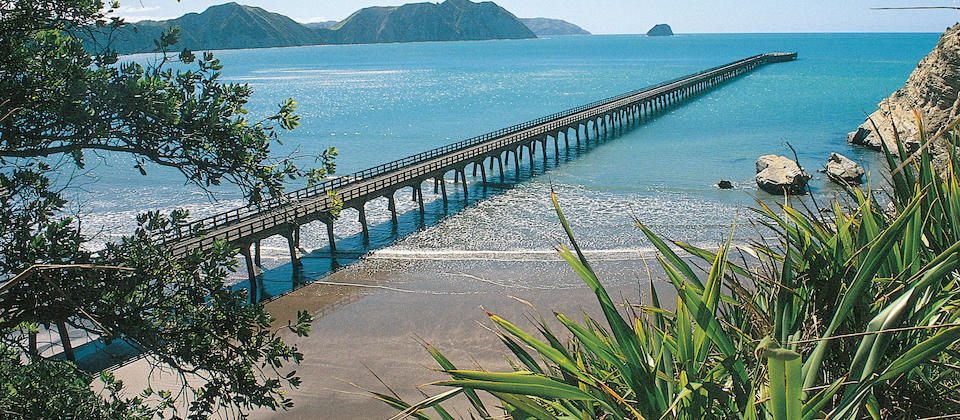It has never ceased to amaze me just how much the European settlers to New Zealand in the mid to late 19th century achieved with their engineering feats. With nothing more than shovels, pick axes, wheelbarrows and dodgy explosives, they constructed awesome bridges and viaducts. They also hacked holes through hills to form tunnels for trains. They cut around cliffs to create beds for train tracks and built lighthouses from stone on impossibly difficult terrain. Some of their projects even involved building structures over water. Although built in the early 20th century, one of the most impressive marine based structures was the wharf at Tolaga Bay which still stands in its elongated glory today.
TOLAGA BAY WHARF
By the early 20th century primitive mechanical machinery had been invented to make building a little easier. However, to build a long wharf out across an isolated bay would’ve been as big a challenge as some of the engineering works that had taken place in the previous decades. In the 1900s, farmers erected a small wharf at the mouth of the Ūawa River, 45 kilometres from Gisborne. They needed it to load their farm produce, mainly wool, grain and meat, into small oar powered boats that would carry it to ships anchored in Tolaga Bay. By the end of the First World War, the little wharf in the river had silted up so the locals needed a new wharf. In 1919, they created the Tolaga Bay Harbour Board then employed a marine engineer to draw up plans for a 100m wharf connected to the shore by a 500m jetty. The engineer declared his structure would cost a staggering £60,000 (equivalent to $5.5 million today). This was out of reach for the tiny community who got together and fundraised then gave a local builder the job of building their wharf.

Work started in January 1926 and problems immediately arose. The approach way proved to be in the wrong place and was shifted during construction. The completed wharf was supposed to offer a depth of 6.4metres but only managed 5.2m. Storm damage to the site in 1928 required the harbour board to find another £20,000 for repair work. Finally, on 22 November 1929, the Minister of Marine declared the wharf open for business. The day was ruined when a group of women with legs dangling over the side of the rail wagon they were seated on brushed against the side of a ship, crushing their legs as it passed too close to the steel hull. However, festivities carried on for the rest of the day although somewhat muted by the accident. At that time the Tolaga Bay Wharf was the longest in New Zealand extending 660m from the shore (the Tiwai Point Wharf at Bluff is now the longest New Zealand wharf at 1,500m)
BIG SHIPS ARRIVE
In December 1929, the local company Geo. H. Scales bypassed the British owned Conference Lines that controlled trade with the UK by sending its deep sea vessel Bencruachan to load direct from Tolaga Bay. 1936 was the most successful year for shipping at the wharf when 133 ships arrived. However, 6 years later, wartime centralisation ended calls to the wharf from the big ‘home boats’ and the wharf became largely redundant.
From the late 1940s, roads across the country had vastly improved and coastal shipping became a less popular means of transport for moving goods around New Zealand. Only a few coasters called now and then at Tolaga Bay. This slow trade wasn’t enough to pay for the maintenance of the deteriorating ferro cement piles. In 1961, the harbour board was wound up and 5 years later (1966) the locally owned coaster Kopara was the last ship to call at the wharf.
TOURIST ATTRACTION
In 1999 locals formed the Tolaga Bay Save the Wharf Charitable Trust to preserve the wharf. Ongoing repair work has made noticeable improvements and today an increasing number of pedestrians use the wharf as it has become one of the area’s biggest attractions. It takes half an hour to stroll along its length and back and those who have made the walk are left with admiration for the early 20th century builders who risked their lives to construct such a marvel out into this isolated New Zealand bay.
HISTORIC LAKE TAUPO WHARF
One of the oldest surviving wharves in New Zealand dates back well over a century. It has become a much loved landmark on the shores of Lake Taupo. Here is what the sign that is placed beside the wharf says.
“It’s hard to imagine Tokaanu as a busy port, but in the late 1800s good roads were few and far between. This meant the easiest way for locals to send their products out to the wider world was by boat. Goods shipped north across the lake included wool, dairy products, and flax; mail and food supplies came in on the return journey. The first steamers anchored offshore and goods and passengers were ferried in on smaller boats. The wharf was probably built in the late 1870s or early 1880s.
The wharf played an important part in the early days of New Zealand tourism. The nearby thermal pools were a highlight on the ‘Grand Tour’ of North Island volcanic attractions. However, this leisurely age of travel came to an end as the roads improved. Regular lake services stopped in the mid 1920s and the wharf began its long, slow decline.
The original section of wharf was built more than 120 years ago and is one of the oldest man-made structures in the area. But in 2002 it was in a sorry and very unsafe state. A restoration project began in 2003 organised by the Department of Conservation with funding assistance from the Tongariro Natural History Society.”
With a growing interest in our history, Kiwis are looking closely at the number of decaying structures around the place that have something to say about the nation’s history. With this new desire to save the past, it’s hoped other historic structures can be saved before they collapse and disappear forever.
If you liked this blog, please leave a comment.
Ceidrik Heward
Ceidrik Heward is an Amazon TOP SELLING AUTHOR and has lived and worked in 7 countries working as a TV cameraman, director and film tutor. For the past 17 years he has focused on writing and has been published in magazines and newspapers in Europe, USA, Asia and the Middle East.
His interests include photography, psychology and metaphysics. He loves to read and always has at least 3 books on the go. He has written 22 manuals/books and has just completed his 4th short novel. Ceidrik believes sharing information and stories is the best way to stimulate the imagination and enrich our lives.




















 Visit Today : 548
Visit Today : 548 Total Visit : 1133725
Total Visit : 1133725
Speak Your Mind